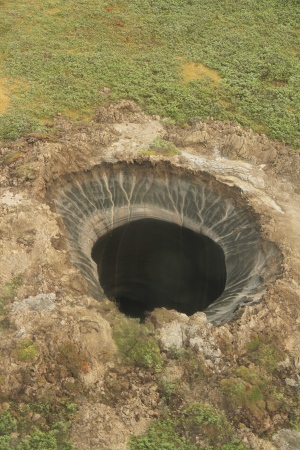I’m sure that, by now, you’ve all seen the pictures of the “craters” in Siberia that had no explanation. I’ve avoided talking about them (as I do for most things) until some understanding exists. I may not be on the forefront of journalism, but that’s not the point.

So, what’s the explanation? Methane.
Methane is the smallest, simplest hydrocarbon. One carbon atom and 4 hydrogen atoms arranged in a tetrahedron around the carbon. If you use “natural gas” for heat in your home, you’re using methane.
If you replace one of the hydrogens with a hydroxide (OH–) then you get methanol which is used as a fuel in racing cars and some other chemical uses. It’s also toxic as hell and should not be drunk under any conditions. But I digress.
The important point here is that methane is a greenhouse gas. And, while it only tends to stay in the atmosphere for eight and a half years, it’s 20 times stronger as a greenhouse gas than carbon dioxide.
Releasing one gigaton of methane gas into the atmosphere is equivalent to 2/3 of all the carbon dioxide generated by human activities in a single year… in terms of greenhouse gas efficiency.
The big problem is that there is a lot of methane trapped in permafrost and as clathrates on the ocean floor. How much?
The estimate of about 11,000 Gt of carbon for ocean sediments, and about 400 Gt for sediments under permafrost regions is in rough accord with an independent estimate by Kvenvolden of 10,000 Gt. MacDonald, Gordon J. Role of methane clathrates in past and future climates. Climate change 3, 247-281 (1990) .
A more recent study doesn’t show that much, but also doesn’t mention permafrost.
Preferred values for these parameters are taken from previous studies of both passive and active margins,
yielding a global estimate of 3 x 1018 g of carbon (3000 Gton C) in clathrate and 2 x 1018 g (2000 Gton C) in methane bubbles. Buffett, B. & Archer, D. Global inventory of methane clathrate: sensitivity to changes in the deep ocean. Earth and Planetary Science Letters 227, 185199 (2004).
Still, we’re talking about thousands of gigatons of methane here. Humans release about 30 gigatons of carbon dioxide per year. At that rate, it would take over 3,000 years to generate the equivalent greenhouse effect as the frozen methane in the oceans.
OK, so methane is frozen in permafrost and the ocean floor. The problem is that these two areas are heating. Warmer temperatures meant that methane ice melts, forms a gas and escapes into the atmosphere, resulting in more warming.
This is a positive feedback loop. Where one conditions increases the amount of a second condition and that second condition increases the amount of the first condition.
Why do scientists think that this crater was cause by methane. Well, the normal percentage of gas in the atmosphere is 0.000179%. The amount of methane near the bottom of the crater was 9.6%. Almost 10,000 times higher.
Another climate research has been studying clathrate deposits.
Our first observations of elevated methane levels, about ten times higher than in background seawater, were documented already as we climbed up the steep continental slope at stations in 500 and 250 m depth. This was somewhat of a surprise. While there has been much speculation of the vulnerability of regular marine hydrates (frozen methane formed due to high p and low T) along the Arctic rim, very few actual observations of methane releases due to collapsing Arctic upper slope marine hydrates have been made. ¨
It has recently been documented that a tongue of relatively varm Atlantic water, with a core at depths of 200–600 m may have warmed up some in recent years. As this Atlantic water, the last remnants of the Gulf Stream, propagates eastward along the upper slope of the East Siberian margin, our SWERUS-C3 program is hypothesizing that this heating may lead to destabilization of upper portion of the slope methane hydrates. This may be what we now for the first time are observing.
So the permafrost is melting, the ocean has been absorbing a lot of heat recently and may be melting clathrates. All of this is releasing one of the more potent greenhouse gases into the atmosphere and there is nothing that we can do to stop it at this point.
Let me just quote Dr. Jason Box.
“We’re on a trajectory to an unmanageable heating scenario, and we need to get off it,” he said. “We’re fucked at a certain point, right? It just becomes unmanageable. The climate dragon is being poked, and eventually the dragon becomes pissed off enough to trash the place.”
The sad part is that there is no good news to this story. There’s no “but we’re using more wind power”, “we’re driving more electric cars”, “we’re reducing carbon dioxide emissions”.
Some are calling it the Methane Catastrophe. We don’t know when it will happen. We know that bits of it have already started. These are the small ice chunks before you get to the glacier that’s about to fall into the sea. It could happen tomorrow or in a hundred years.
Unless we, as a planet, get on top of this thing, then we are “fucked”.
We have the technology to stop producing much of the carbon dioxide that we use (and some of the methane). What we cannot do is stop a global process that has already begun. We cannot cool the oceans. We cannot refreeze permafrost.
It’s like a bottle of beer that you left in the car all day. You can put it in the freezer, but it’s not going to be drinkable in just 10 minutes.
I know, I’m a gloom and doom person. It’s my nature. But very few people are even thinking about this as a problem, much less how to stop it.
